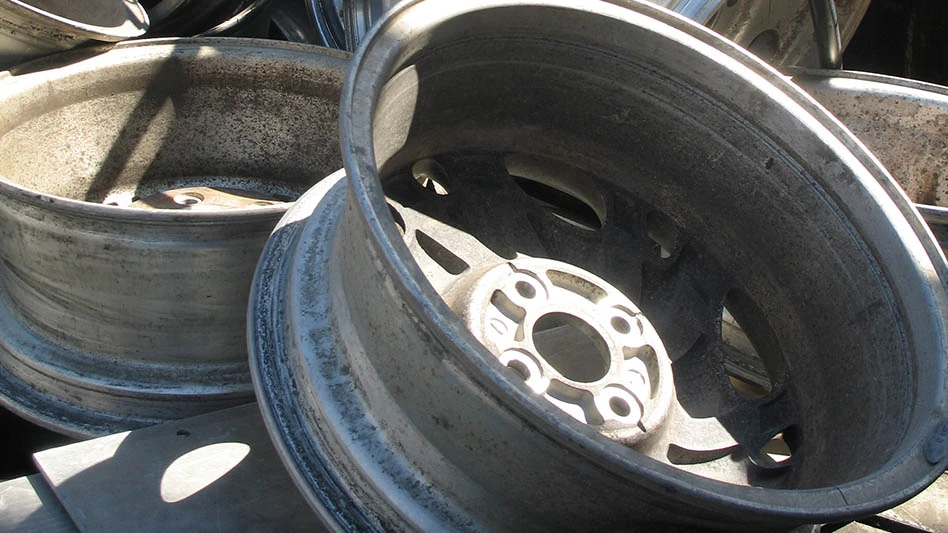 Plastics has been one of the fastest growing sectors of the recycling industry. During the past several years, an explosion of new capacity has come online to consume various grades of pre- and post-consumer plastic scrap. This recent success has been accompanied by growing pains, as definitions, standards and quality levels may vary significantly among recyclers and consumers of plastic scrap.
Plastics has been one of the fastest growing sectors of the recycling industry. During the past several years, an explosion of new capacity has come online to consume various grades of pre- and post-consumer plastic scrap. This recent success has been accompanied by growing pains, as definitions, standards and quality levels may vary significantly among recyclers and consumers of plastic scrap.
To bring some consistency to recycled plastics markets, the Institute of Scrap Recycling Industries Inc. (ISRI), Washington, D.C., has modified its plastics scrap specifications circular.
ISRI's board of directors recently approved the updated specifications.
In a press release announcing the new specifications, ISRI President Robin Wiener says, "It is important that specifications are updated and revamped when necessary. We have seen a clear need for common ground when it comes to specifications for recycled plastics. One of our priorities here at ISRI is to ensure the free and fair trade of commodities in a way that can be understood in our global economy."
Jonathan Cohen, chair of ISRI's Plastics Recycling Council and president of Generated Materials Recovery, Phoenix, says, "Historically, the recyclable plastics commodities market has been plagued with confusion surrounding the acceptable specifications of even the most commonly traded grades. This has resulted in increased market transaction costs and risk for all parties.
 Courtesy of the U.S. Bureau of Labor Statistics; index is based on December 1980 average prices as 100 Courtesy of the U.S. Bureau of Labor Statistics; index is based on December 1980 average prices as 100 |
"As such, the over-arching objective of the ISRI scrap specs initiative is to help improve market efficiency by establishing clear guidelines for the major grades of plastics traded by ISRI members on a national and international basis," he says.
Cohen addresses these issues in the Q&A that follows with Dan Sandoval, senior and Internet editor of Recycling Today (RT).
RT: Briefly describe the process by which you assembled input for the plastics scrap specifications.
Jonathan Cohen (JC): The ISRI Plastics Recycling Council formed a Plastics Commodities Specifications Committee. The objective of the committee is to review, revise and refresh the ISRI plastics specifications to increase their utility in the global marketplace.
RT: How many people participated in the process?
JC: Approximately 15 people participated in the process. The group is comprised of plastics industry veterans, experienced metals and paper dealers and people newer to plastics but eager to learn to grow their businesses into this sector.
RT: Will the specifications be updated/adjusted on a regular basis?
JC: The plan is to update the entire set of specifications by the end of 2012 and then to review them once per year or as emergent market conditions warrant.
|
More Questions Jonathan Cohen, chair of the Institute of Scrap Recycling Industries Inc. (ISRI's) Plastics Recycling Council and president of Generated Materials Recovery, Phoenix, answered these additional questions that Recycling Today (RT) Senior Editor Dan Sandoval posed to him: RT: What are some of the unique dynamics that handlers of industrial plastics need to be aware of? Jonathan Cohen (JC): In order to maximize its value, each post-industrial recycled plastics grade must be kept separate from any other grade; and, if a grade is contaminated with another grade, the value can practically evaporate. Therefore, there is significant upside but also great risk in handling these materials. RT: For industrial grades of plastic scrap, what end-market opportunities are available? Are there supply constraints? JC: For clean and homogeneous grades of post-industrial recycled plastics grades there is far more demand than supply. There are unlimited end market applications because, if the polymer type is known and is contaminant free, many manufacturers can use the reprocessed pellets (made from scrap) as a substitute for the prime resin of that polymer they would normally have to purchase. RT: Are there particular segments of the industrial plastics side of the business that hold the best opportunities for plastics recyclers? JC: There are certain grades that are easy operationally to identify and bale, present low risk of contamination and, in essence, market themselves because there is so much demand. These are the grades recyclers that are new to plastics should focus on recovering. Examples are grades such as HMW (high-molecular-weight) HDPE (high-density polyethylene) drums, HDPE crates and HDPE buckets. RT: What are some of the biggest challenges in dealing with industrial plastics? JC: Contamination risk is the greatest challenge. End users will pay a premium for the correct grade but will often outright reject a load completely if it even has minor levels of contamination. |
RT: What revisions/changes did the Plastics Commodities Specifications Committee make to the specifications?
JC: We revised existing specifications, eliminated some specifications that were not practical and created three new specifications. All the current specifications can be viewed through the ISRI website (www.isri.org). We plan to continue this process and improve the specifications guide each quarter.
There seems to be a real hunger in the industry for better definitions and clear standards for the plastics grades that are commonly traded. Our intent is to create specifications that reflect the actual trade to help alleviate any misunderstandings between buyers and sellers.
RT: What role should consumers of plastic scrap take in developing and fine-tuning the specifications?
JC: The consumers' role is to help guide the generators and the aggregators of recyclables as to the most economically and operationally viable options to market the commodities.
RT: Overseas buyers are a significant consumer of various grades of plastic scrap. Do you feel these consumers will accept these specifications?
JC: Foreign buyers and export brokers are very concerned with the material quality risk of what they purchase. To the extent that the ISRI plastics specifications will reduce their risk, these buyers will use them.
RT: Is it challenging to come up with workable definitions for plastics grades when the range of materials can be so broad?
JC: The opportunity is to create a set of material guidelines that will help alleviate confusion and mitigate risk for all parties in the plastics market. Even with more complex or mixed materials, a common vocabulary and well-understood expectations can be established that will reduce transaction costs and risk for both sellers and buyers.
RT: What do you feel is the biggest challenge to having the plastic scrap specifications adopted/accepted by more people?
JC: Achieving widespread utility for the ISRI plastics specifications is the top priority and the greatest challenge. Currently, there are a multitude of concepts across the market as to what each grade consists of, what is acceptable to buyers and what these grades are even called. We hope to decrease the size of each of these gaps in common understanding.
RT: What are some of the biggest opportunities possible with uniform standards for plastic scrap grades?
JC: The plastics market is far less mature than the metals and paper markets, yet it is growing the fastest and there is great interest in these "new" grades among established recyclers. The overall rates of plastics recovery should increase as the specifications become more widely disseminated, creating new areas of revenue growth for generators and aggregators of recyclable commodities.
RT: What is the next step regarding the specifications?
JC: Each month, the ISRI Plastics Recycling Council Specifications Committee meets to continue work on this initiative. We invite all ISRI members to participate and any other interested parties to join ISRI and become part of the process in order to ensure their voices are heard.
RT: How receptive are plastics scrap consumers to taking in more secondary plastics?
JC: There is growing interest by end users for two primary reasons. One, they can reduce their raw material costs when they purchase recycled plastics. Two, they can market their finished products as environmentally conscious, which is attractive to consumers.
RT: Are there any particular issues that you feel people should be aware of?
JC: The recycled plastics market is still relatively immature but it is developing rapidly.
Many long-established fiber recyclers still refer to all plastics as "nonfiber" because that is how they historically viewed them. It refers to everything other than fiber, which has been their core business. Yet these same companies recognize that the overall recovered fiber volumes are decreasing and that the nonmetallic, "nonfiber" opportunity is significant and growing.
I anticipate that more traditional fiber recyclers will enter into this newer market and seek to recover many grades of plastics going forward.
RT: As more grades and higher volumes of plastics are being collected, do you see quality issues growing?
JC: Quality control is a concern for all sectors of recyclable commodities, and plastics grades are no different. The challenge is to educate all parties in the marketplace. It is of no value to sellers or buyers to have material quality problems.
RT: Can technology improve the consistency of the plastics material being collected for recycling?
JC: Consistent quality is a result of engaged and accountable plant managers. Technology is a secondary matter. It may help, but it also may not; it depends on the operational utility of the technology in question.
Jonathan Cohen is president of Generated Materials Recovery, based in Phoenix, and chair of ISRI's Plastic Recycling Council.
Latest from Recycling Today
- RMDAS April figures show recycled steel price setback
- Steer World offers PEX plastic recycling machine
- New recycling grant program launches in Massachusetts
- Tire Recycling Foundation names executive director
- Dock 7 named 2025 Exporter of the Year at New Jersey International Trade Awards
- Waste Connections reports ‘better than expected’ Q1 results
- Commentary: How EPR is transforming the packaging industry
- Acerinox names new North American Stainless CEO





